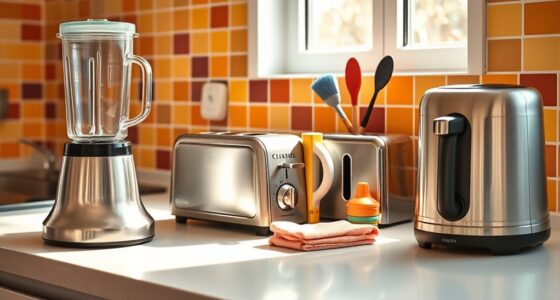To safely handle and store knives and electric cutters, always keep blades sharp and inspect them regularly. Use proper tools when handling blades, always disconnect power before maintenance, and store them in secure, dry places like sheathed or covered in designated areas. Keep your workspace organized and guarantee tools are unplugged when not in use. Continuing will help you discover essential tips to prevent accidents and extend your tools’ lifespan effectively.
Key Takeaways
- Always disconnect power and wear protective gloves before handling or maintaining blades.
- Store knives and electric cutters in designated, secure locations away from traffic or children.
- Keep blades sheathed or covered when not in use to prevent accidental contact.
- Regularly inspect blades for damage, and sharpen or replace them as needed for safety.
- Maintain a clean, dry storage environment to prevent rust, corrosion, and accidental injuries.

Handling knives and electric cutters safely is fundamental to prevent accidents and injuries in any setting. One of the most important aspects of safety is proper blade maintenance. Keeping blades sharp ensures cleaner cuts and reduces the risk of slipping. Dull blades require more force, increasing the chance of losing control and causing cuts. Regularly inspect blades for damage or wear, and replace or sharpen them as needed. Proper blade maintenance not only enhances safety but also extends the lifespan of your tools, saving you money and effort in the long run. When performing blade maintenance, always disconnect power sources or remove blades entirely to prevent accidental activation. Handle blades carefully with appropriate tools, and avoid touching sharp edges directly to prevent cuts. Remember, a well-maintained blade is safer and more efficient. Additionally, understanding the Comparative Advantage Principle can help in optimizing how tools are allocated and maintained for safety and efficiency.
Storage safety is another critical factor to contemplate. How you store your knives and electric cutters can greatly influence safety in your workspace. Always keep blades sheathed or covered when not in use to prevent accidental contact. Store knives and cutters in designated areas, away from high-traffic zones or places where they might fall or be mishandled. Use secure storage solutions like knife blocks, magnetic strips, or locked drawers to prevent unauthorized access, especially if children or untrained individuals are around. Additionally, ensure that blades are stored dry and free from moisture to avoid rust and corrosion, which can weaken the blade structure and create hazards during use. When storing electric cutters, disconnect them from power and keep cords neatly wound to prevent tripping or accidental activation. Proper storage safety involves more than just keeping blades out of reach; it’s about creating an environment where accidents are unlikely.
Frequently Asked Questions
How Often Should Knives and Cutters Be Inspected for Damage?
You should inspect knives and cutters daily for damage detection. Regular inspection frequency guarantees you catch any signs of wear, cracks, or dullness early, preventing accidents or product contamination. Before each use, take a quick moment to check for damage, and perform more thorough inspections weekly. This proactive approach keeps your tools in peak condition, enhances safety, and maintains efficiency in your work.
What Are the Best Practices for Disposing of Dull or Broken Blades?
Think of dull or broken blades as ticking time bombs—you don’t want them around. You should carefully place them in designated disposal containers to prevent accidents. Before disposal, consider blade sharpening if they’re just dull; otherwise, safely discard broken blades. Always wear gloves for protection. Proper disposal guarantees safety for everyone and keeps your workspace hazard-free. Never toss blades loosely; use the right disposal containers every time.
Are There Specific Storage Methods for Different Types of Knives?
You should use designated knife storage solutions, like knife blocks, magnetic strips, or protective sheaths, to keep different types organized and safe. For cutter organization, consider separate compartments or drawers to prevent blades from dulling or damaging each other. By categorizing your knives and cutters, you guarantee easy access, maintain sharpness, and reduce the risk of accidents, making your workspace safer and more efficient.
How Can I Prevent Corrosion on Electric Cutters in Humid Environments?
To prevent corrosion on electric cutters in humid environments, you should regularly clean and dry the equipment after use, avoiding moisture buildup. Apply a light coating of protective oil or corrosion inhibitor to metal parts, and store the cutter in a dry, well-ventilated area. Using silica gel packs or dehumidifiers nearby can also help control humidity levels, ensuring your electric cutters stay in good condition and resist corrosion effectively.
What Personal Protective Equipment Is Recommended When Handling Knives?
Wearing the right personal protective gear is essential to keep you safe from cuts and injuries. You should always use high-quality knife safety gloves that provide a barrier between your skin and sharp blades. Additionally, consider eye protection and cut-resistant sleeves for full safety. Don’t underestimate the danger—these tools can cause serious harm if mishandled. Proper gear guarantees you stay safe and confident while handling knives.
Conclusion
Remember, mishandling knives and electric cutters isn’t just a recipe for disaster — it’s an invitation for your kitchen to turn into a crime scene. Treat your tools like precious treasures, not rogue weapons craving chaos. Store them safely, handle them with respect, and avoid becoming the star of your own slapstick injury sitcom. Keep safety sharp and accidents dull; your fingers will thank you, and you’ll keep your kitchen drama-free.









